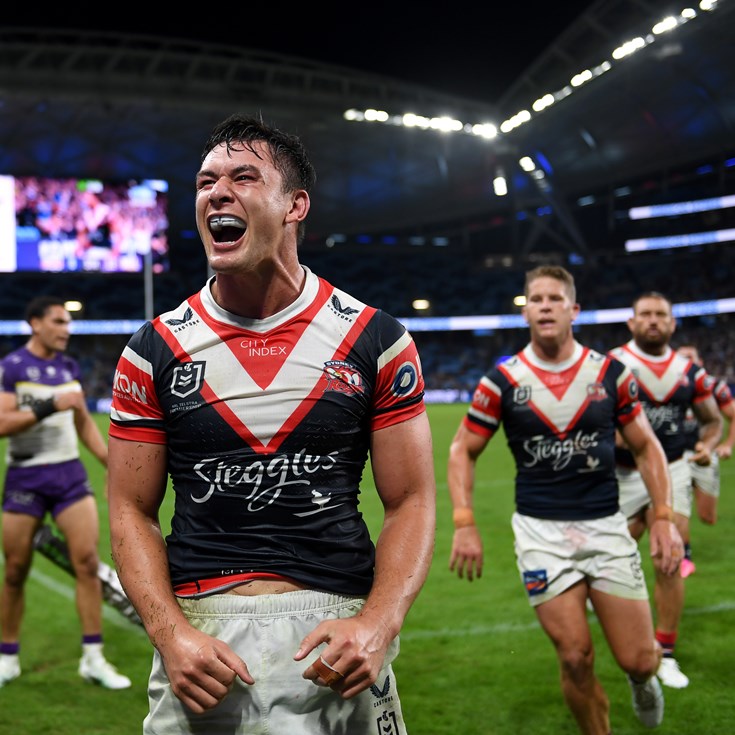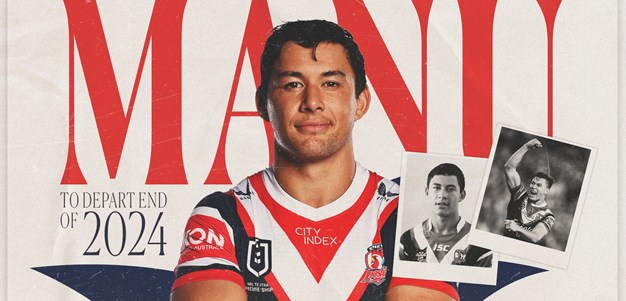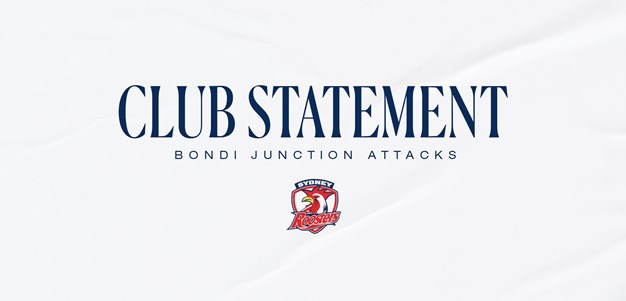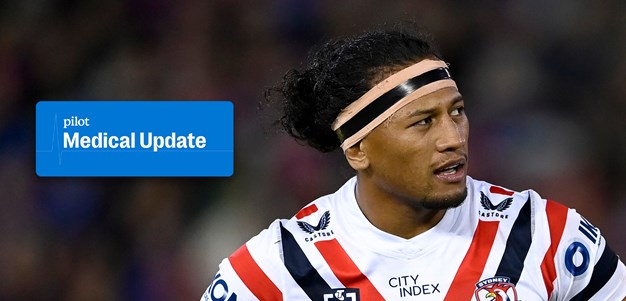Life-long Sydney Roosters fan Alan Katzmann has joined the Roosters.com.au team for the 2013 season and will contribute regular opinion pieces on subjects of interest to our supporters, and league followers in general.
A 12-year Member and Eastern Suburbs local, Alan is one of the tricolours most passionate followers and a proud member of the recently established Jack Gibson Club.
THE CHANGE IN THE GAME THAT YOU MAY HAVE MISSED
The game of rugby league is in continual evolution, and over the past 5-6 years one of the big shifts has been the changing role of backrow forwards which has received very little explanation or analysis.
For many years, once the lock forward became a permanent part of the main defensive line, it was hard for fans to differentiate between locks and second rowers. Furthermore, their roles differed from club to club. However, in recent years we have seen a dramatic change where we essentially now have middle and wide forwards.
The wide forwards are the two second rowers positioned at either side of the ruck. In defence they are positioned as the fourth players in from the sideline, and in attack they are positioned three players in, with just the centre and the winger outside them, like an old-fashioned inside centre. Second rowers need to have sufficient pace to take advantage of the additional room afforded to players who attack out wide as well as being able to set up their outside backs with the ability to draw and pass. They need to be big and strong enough to bust tackles and make as many as 30 tackles per game.
While the rugby league international federation (IRLF) does not formally recognise left and right second rowers in the numbering of positions in the same way they recognise left and right centres and wingers (just listing the two second rowers without differentiation as numbers 11 and 12), many second row forwards these days do specialise as left or right, and tend to be far less effective if played on the opposite side of the field, in much the same way as many centres and wingers are far more comfortable playing on their preferred side of the field. It is hard to ever imagine, for example, seeing Storm second rower Ryan Hoffman playing anywhere but on the left side of the field in much the same way that we will never see Dragons centre Matt Cooper playing on the right side of the field.
I have created the following diagrams to help illustrate the modern defensive formations, with the odd slight variation. Halfback and five eighth defend three in on either side of the field. The side they defend on depends on the individual player strengths of those players and those who defend beside them, and are referred to in the diagrams as Inside back (L) and Inside back (R).



As you can see in the diagram, we have four players in the standard defensive line (two markers and two players either side of the ruck) that have been defined as middle forwards. These are the two props, the hooker and the lock. The lock forwards role has been the one that has changed more dramatically than any other position. The lock should no longer be referred to as a backrow forward as he is now a middle forward and his role is much closer to that of a prop. Some second row forwards have made the transition to the middle but you wont see many, if any, going the other way. Some older players like Willie Mason, Luke ODonnell and Joe Galavao are examples of former second rowers who will finish their careers as middle players after making the transition in recent years. Nathan Hindmarsh and Anthony Watmough are two others who have made the transition to middle forwards over the past five or six years, but these two continued to wear number 11 on their jersey (and as a result forced one of their second rowers to wear number 13), a situation which the NRL has allowed for some reason, in much the same way in which they continue to allow clubs to number their three quarters anyway they feel, despite the IRLF clearly stating that right side three quarters wear 2 and 3 and left side three quarters wear 4 and 5. This has been confusing for fans and prevented many from fully grasping the changes in the game which we are discussing here today. I have always believed that the more fans understand our game, the more they will appreciate and support it, so matching numbers to positions is vital in this educational process.
In some clubs the roles of lock and prop are interchangeable, particularly from the interchange bench, but most have at least one specialist lock in their best 17 that plays a slightly different role from that of a prop. A specialist lock should have the ability to ball-play before, and at, the defensive line. He needs to be heavier than a second row forward due to the additional workload in the middle, but lighter than a prop to enable him to play a greater number of minutes. Players like Canberras Shaun Fensom, Brisbanes Corey Parker and Newcastles Jeremy Smith are great examples of the modern-day specialist lock. In attack they are not the metre-eaters that you expect props to be, and as such their hit-ups are likely to be measured by quality rather than quantity, but you would expect them to be in the top three offloaders each week. Some of these specialist locks may have been second rowers in their younger days and may not have had quite the speed required to play in the second row, but have since bulked up sufficiently to play in the middle. However, many are chosen to play lock because of their great endurance levels and tackling techniques and, as stated, a ball-playing ability greater than the average forward.
Locks like the Dragons Trent Merrin, our own Frank Paul Nuuausala and Wests Tigers Adam Blair are former props who can easily alternate between prop and lock but are more suited to lock these days due to shedding those kilos necessary to play that lock role more effectively. A third type of lock is often used as an interchange player doubling up as the teams second hooker. Melbournes Ryan Hinchcliffe is a vital member of Craig Bellamys squad, and after playing this interchange role for a while, is now the teams starting lock, giving the Storm the luxury of carrying a wide forward on the bench. Recently retired Dragons premiership winner Dean Young and Souths Nathan Peats are other examples of this type of lock, who are likely to ball-play before rather than at the defensive line, but are also likely to jump into dummy half from time to time from a quick play the ball and take off from there.
The changes that I have detailed have significantly changed the way teams are structured, particularly in defence. Identifying and understanding the roles played by wide and middle forwards should hopefully assist your viewing of the game and appreciation of decisions made by the club in recruitment, retention and team selection. These adjustments have also had a major impact on how sides construct their interchange benches. In the next edition of Chiming into the backline I will write about this impact and how clubs determine the make-up of their interchange benches in the modern game.
NB: The views expressed in this article do not necessarily represent the views of Roosters.com.au, the Sydney Roosters and its board of Directors or staff.
A 12-year Member and Eastern Suburbs local, Alan is one of the tricolours most passionate followers and a proud member of the recently established Jack Gibson Club.
THE CHANGE IN THE GAME THAT YOU MAY HAVE MISSED
The game of rugby league is in continual evolution, and over the past 5-6 years one of the big shifts has been the changing role of backrow forwards which has received very little explanation or analysis.
For many years, once the lock forward became a permanent part of the main defensive line, it was hard for fans to differentiate between locks and second rowers. Furthermore, their roles differed from club to club. However, in recent years we have seen a dramatic change where we essentially now have middle and wide forwards.
The wide forwards are the two second rowers positioned at either side of the ruck. In defence they are positioned as the fourth players in from the sideline, and in attack they are positioned three players in, with just the centre and the winger outside them, like an old-fashioned inside centre. Second rowers need to have sufficient pace to take advantage of the additional room afforded to players who attack out wide as well as being able to set up their outside backs with the ability to draw and pass. They need to be big and strong enough to bust tackles and make as many as 30 tackles per game.
While the rugby league international federation (IRLF) does not formally recognise left and right second rowers in the numbering of positions in the same way they recognise left and right centres and wingers (just listing the two second rowers without differentiation as numbers 11 and 12), many second row forwards these days do specialise as left or right, and tend to be far less effective if played on the opposite side of the field, in much the same way as many centres and wingers are far more comfortable playing on their preferred side of the field. It is hard to ever imagine, for example, seeing Storm second rower Ryan Hoffman playing anywhere but on the left side of the field in much the same way that we will never see Dragons centre Matt Cooper playing on the right side of the field.
I have created the following diagrams to help illustrate the modern defensive formations, with the odd slight variation. Halfback and five eighth defend three in on either side of the field. The side they defend on depends on the individual player strengths of those players and those who defend beside them, and are referred to in the diagrams as Inside back (L) and Inside back (R).
As you can see in the diagram, we have four players in the standard defensive line (two markers and two players either side of the ruck) that have been defined as middle forwards. These are the two props, the hooker and the lock. The lock forwards role has been the one that has changed more dramatically than any other position. The lock should no longer be referred to as a backrow forward as he is now a middle forward and his role is much closer to that of a prop. Some second row forwards have made the transition to the middle but you wont see many, if any, going the other way. Some older players like Willie Mason, Luke ODonnell and Joe Galavao are examples of former second rowers who will finish their careers as middle players after making the transition in recent years. Nathan Hindmarsh and Anthony Watmough are two others who have made the transition to middle forwards over the past five or six years, but these two continued to wear number 11 on their jersey (and as a result forced one of their second rowers to wear number 13), a situation which the NRL has allowed for some reason, in much the same way in which they continue to allow clubs to number their three quarters anyway they feel, despite the IRLF clearly stating that right side three quarters wear 2 and 3 and left side three quarters wear 4 and 5. This has been confusing for fans and prevented many from fully grasping the changes in the game which we are discussing here today. I have always believed that the more fans understand our game, the more they will appreciate and support it, so matching numbers to positions is vital in this educational process.
In some clubs the roles of lock and prop are interchangeable, particularly from the interchange bench, but most have at least one specialist lock in their best 17 that plays a slightly different role from that of a prop. A specialist lock should have the ability to ball-play before, and at, the defensive line. He needs to be heavier than a second row forward due to the additional workload in the middle, but lighter than a prop to enable him to play a greater number of minutes. Players like Canberras Shaun Fensom, Brisbanes Corey Parker and Newcastles Jeremy Smith are great examples of the modern-day specialist lock. In attack they are not the metre-eaters that you expect props to be, and as such their hit-ups are likely to be measured by quality rather than quantity, but you would expect them to be in the top three offloaders each week. Some of these specialist locks may have been second rowers in their younger days and may not have had quite the speed required to play in the second row, but have since bulked up sufficiently to play in the middle. However, many are chosen to play lock because of their great endurance levels and tackling techniques and, as stated, a ball-playing ability greater than the average forward.
Locks like the Dragons Trent Merrin, our own Frank Paul Nuuausala and Wests Tigers Adam Blair are former props who can easily alternate between prop and lock but are more suited to lock these days due to shedding those kilos necessary to play that lock role more effectively. A third type of lock is often used as an interchange player doubling up as the teams second hooker. Melbournes Ryan Hinchcliffe is a vital member of Craig Bellamys squad, and after playing this interchange role for a while, is now the teams starting lock, giving the Storm the luxury of carrying a wide forward on the bench. Recently retired Dragons premiership winner Dean Young and Souths Nathan Peats are other examples of this type of lock, who are likely to ball-play before rather than at the defensive line, but are also likely to jump into dummy half from time to time from a quick play the ball and take off from there.
The changes that I have detailed have significantly changed the way teams are structured, particularly in defence. Identifying and understanding the roles played by wide and middle forwards should hopefully assist your viewing of the game and appreciation of decisions made by the club in recruitment, retention and team selection. These adjustments have also had a major impact on how sides construct their interchange benches. In the next edition of Chiming into the backline I will write about this impact and how clubs determine the make-up of their interchange benches in the modern game.
NB: The views expressed in this article do not necessarily represent the views of Roosters.com.au, the Sydney Roosters and its board of Directors or staff.










